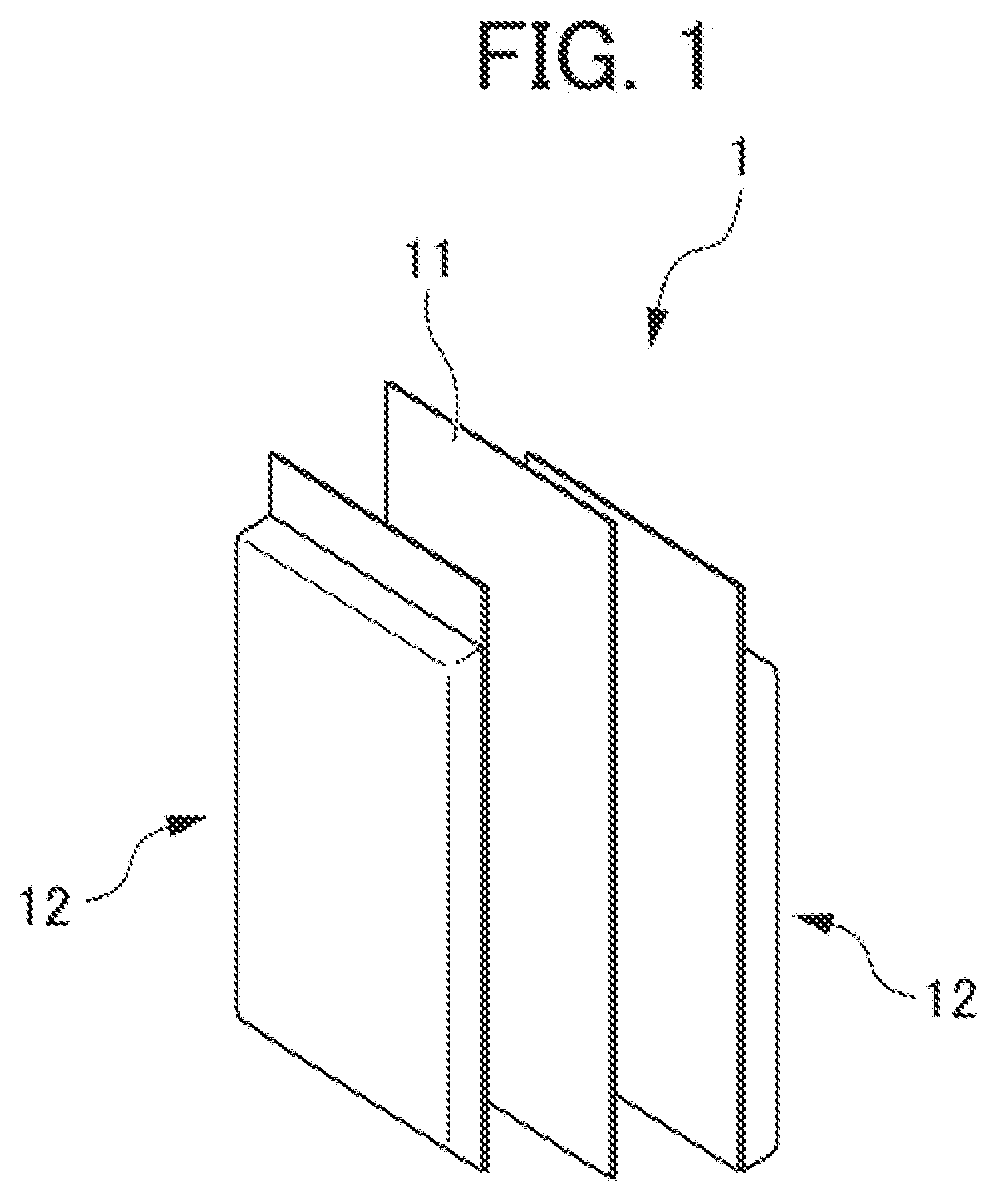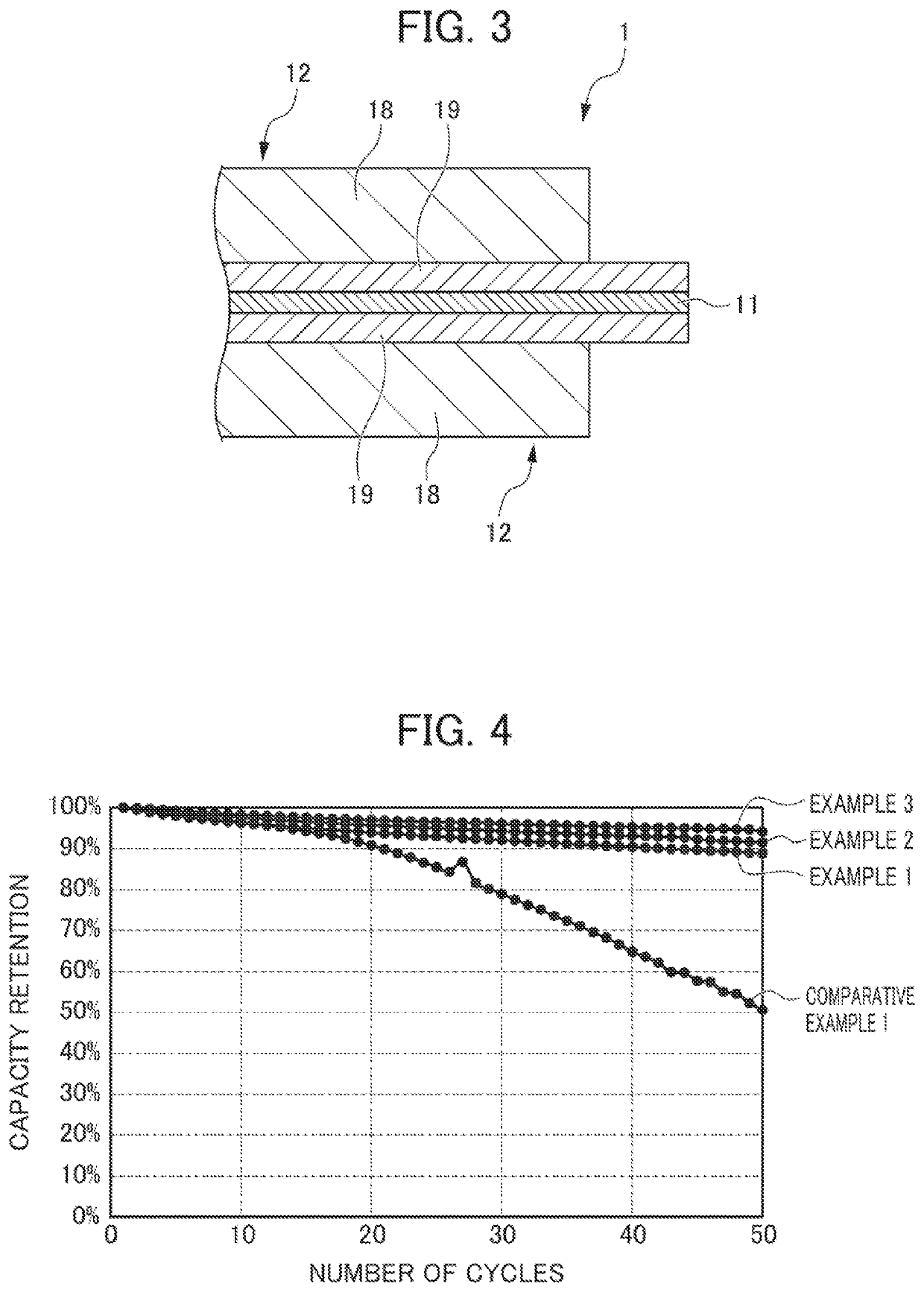Nonaqueous electrolyte secondary battery negative electrode and nonaqueous electrolyte secondary battery comprising the same
a secondary battery and nonaqueous electrolyte technology, applied in the direction of active material electrodes, cell components, electrical apparatuses, etc., can solve the problems of difficult manufacturing of high-precision negative electrodes, uneven coating, and limit of thickness of negative electrodes, so as to reduce battery performance and reduce cycle life , the effect of suppressing falling
- Summary
- Abstract
- Description
- Claims
- Application Information
AI Technical Summary
Benefits of technology
Problems solved by technology
Method used
Image
Examples
first embodiment
[0024][Negative Electrode]
[0025]FIG. 1 is a figure schematically illustrating the configuration of a nonaqueous electrolyte secondary battery negative electrode 1 according to a first embodiment of the present invention. The nonaqueous electrolyte secondary battery negative electrode 1 according to the present embodiment has current collecting foil 11 and a pair of current collectors 12 disposed in contact with both surfaces of the current collecting foil and comprising a porous metal body. FIG. 2 is a figure schematically illustrating how a negative electrode material 13 is disposed in a pore of a current collector 12 comprising the porous metal body. The negative electrode material 13 comprises a negative electrode active material 14 comprising a silicon-based material, a skeleton-forming agent 15 containing a silicate having siloxane bonds, a conductive auxiliary 16, and a binder 17. Even though the negative electrode active material 14 filled into the current collector 12 expand...
second embodiment
[0089]As another embodiment of the nonaqueous electrolyte secondary battery negative electrode of the present invention, an aspect having a region contacting with the current collecting foil and not filled with a negative electrode material or a region having a low filling density of the negative electrode material as compared with other regions in at least one of a pair of current collectors comprising a porous metal body (hereinafter also called a second embodiment) will also be described in detail with reference to a figure.
[0090]FIG. 3 is a sectional view schematically illustrating the configuration of a nonaqueous electrolyte secondary battery negative electrode 1 according to the present embodiment. The present embodiment has a region 18 having a high filling density of a negative electrode material and a region not filled with the negative electrode material 13 and provided in contact with current collecting foil 11 or a region having a low filling density of the negative ele...
example 1
[0110][Manufacturing of Negative Electrodes]
[0111]Slurry containing silicon (particle size: 1 to 10 μm) as a negative electrode active material, acetylene black as a conductive auxiliary, polyvinylidene fluoride (PVDF) as a binder was prepared. Subsequently, the prepared slurry was filled into “nickel CELMET”® manufactured by Sumitomo Electric Industries, Ltd. as current collectors so that the coating amount was 5 mg / cm2. Then, the coated current collectors were dried and subjected to pressure control treatment to obtain negative electrode layer precursors.
[0112]Meanwhile, an aqueous 10% by mass solution of Na2O.3SiO2 was prepared as skeleton-forming agent liquid containing a skeleton-forming agent and water. The negative electrode layer precursors obtained above were immersed in the prepared skeleton-forming agent liquid. After the immersion, the precursors of negative electrodes were heated at 160° C. and dried to obtain monolayer negative electrodes in which negative electrode la...
PUM
| Property | Measurement | Unit |
|---|---|---|
| thickness | aaaaa | aaaaa |
| thickness | aaaaa | aaaaa |
| filling density | aaaaa | aaaaa |
Abstract
Description
Claims
Application Information
 Login to View More
Login to View More - R&D
- Intellectual Property
- Life Sciences
- Materials
- Tech Scout
- Unparalleled Data Quality
- Higher Quality Content
- 60% Fewer Hallucinations
Browse by: Latest US Patents, China's latest patents, Technical Efficacy Thesaurus, Application Domain, Technology Topic, Popular Technical Reports.
© 2025 PatSnap. All rights reserved.Legal|Privacy policy|Modern Slavery Act Transparency Statement|Sitemap|About US| Contact US: help@patsnap.com



